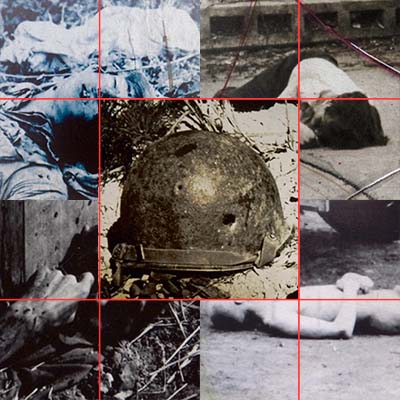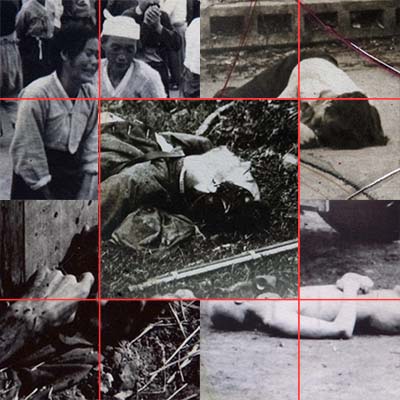
Polk speaks about the series, Life After Death
"In August of 2008, I visited the National Archives in College Park, Maryland, to look at the photographs held in its vaults. Hundreds of thousands of photographs, collected over the years, taken by the various government agencies, are stored there. They were produced through the use of U.S. tax revenues, and therefore considered to be the property of those who pay taxes. There are no copyright limitations on their use, and it was my plan to identify images that I would use in my art to commemorate critical moments in American history. Because much of what I chose to look at was related to the military, I would periodically encounter depictions of the dead. "
"My first such encounter was in a photo taken in Vietnam during that war. It was of a couple of US soldiers walking down a dirt road and passing a small group of dead villagers. The villagers were strewn down and contorted as though they had been hurled by huge blast. Immersed in mud and weeds, absent of dignity – they could have been discarded gum wrappers or cigarette butts carelessly tossed by the side of the road. The soldiers showed no emotion."
"It appeared to me that they were attempting to be unshaken, hardening themselves, and refraining from thinking about the living souls who had previously inhabited these contorted bodies."
"My response to this photograph was one of heartache and anguish. I was sickened. I immediately turned to the next image, seeking to escape to something more comfortable, and I attempted to disregard it as anything appropriate for my purposes."
"However, as I continued to run across more and more of these horrific images, I began to discover a growing personal need to acknowledge them. They were just too powerful to ignore. I became increasingly unable to pass them by, and I began to realize that I would have to put to use them in my art."
"The works in this series are about looking at history with an eye to what follows. The exhibit title, “Life After Death”, articulates the idea not only that life continues after death, but that life is influenced by the deaths which precede it. Each life is interwoven with those from before and after. We are who we are, and what we are, because of the events that precede us."
Life After Death is comprised of c. 40 works including variations. All works contain digital tromp-l'oil elements that blur the distinction between the real and its illusion. E.g., Collages are photographed, printed, abused (soiled, ripped, burned, stained, and/or painted), re-photographed, and then further abused.
Each piece includes:
- A reproduced photograph from the US National Archives
- Its official documentation (description, date, photographer, etc.)
- A story, handwritten on old note paper.
The Story is invented to humanize the depicted dead and to contextualize them within the interweave of humanity through all generations. The pieces are to be thought of as the refuse from the ruins that reveals the lives from before.





